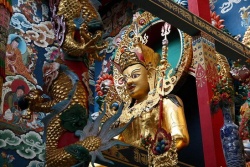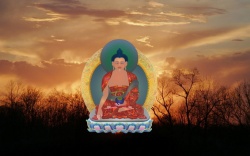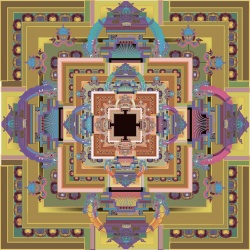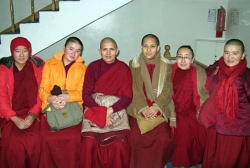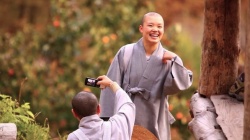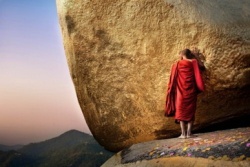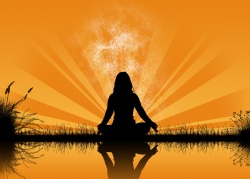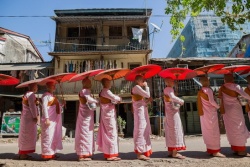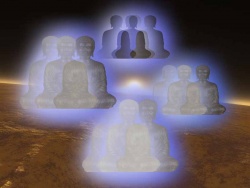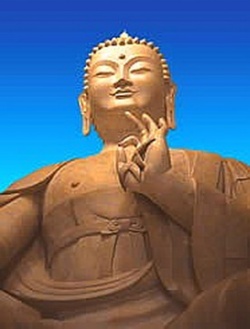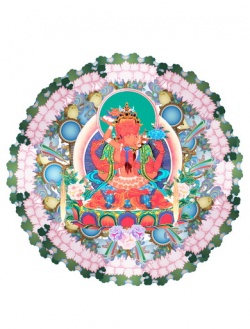Tantric Practice
- "The more we train to see ourselves as such a meditational deity,
- This divine self-visualisation empowers us to take control of our life
- and create for ourselves a pure environment
- in which our deepest nature can be expressed."
Why Is Tantra Called A Swift Method?
"The wisdom that realizes emptiness, that has gained insight into the nature of reality, is of varying kinds, depending upon the level of subtlety of the consciousness perceiving the emptiness. In general, there are rough levels of consciousness, more subtle levels, and then the innermost subtle level of consciousness. It is the uncommon characteristic of Tantric practice that through it one can evoke this most subtle consciousness at will and put it to use in a most effective way. For example, when emptiness is realized by this subtlest level of mind, it is more powerful, having a much greater effect on the personality.
In order to activate or make use of the more subtle levels of consciousness, it is necessary to block the rougher levels--the rougher or grosser levels must cease. It is through specifically Tantric practices, such as the meditations on the chakras and the channels, that one can control and temporarily abandon the rougher levels of consciousness. When these become suppressed, the subtler levels of consciousness become active. And it is through the use of the subtlest level of consciousness that the most powerful spiritual realizations can come about. Hence, it is through the Tantric practice involving the most subtle consciousness that the goal of enlightenment can most quickly be realized."
From Answers: Discussions with Western Buddhists by the Dalai Lama
Initiation
Depending on the specific lineage and class of tantra, a Guru can demand that the disciple will commit to a daily practice (like reciting a certain number of mantras or doing a daily meditation practice). Next, a ritual is carried out in which the Guru transmits the potential of the specific tradition of the practice and gives the permission to practice. Highly qualified disciples sometimes achieve immediate realisations due the combined power of this transmission and their practice (maybe in previous lives).
If you seriously intend to take an initiation, please verify the following beforehand:
- Do I have a reasonable understanding of renunciation, bodhicitta and emptiness? (Please check out the page Preliminaries to Tantra.)
- What are the prerequisites of this initiation? Am I prepared to do the preliminaries?
- What are the vows I need to take? Am I willing to take aspiring Bodhisattva, Bodhisattva or even tantric vows?
- Why do I really want to receive the permission for this practice? Do I want to practice it, or is it only because everyone else is going?
- What are the daily commitments? Am I prepared to do these daily practices every day for the rest of my life?
- Are there retreat commitments? What does this retreat mean?
- Last, but perhaps even most important is the teacher. Do I really have full confidence in him/her? Have I checked this person out? Does the teacher accept me as his/her disciple? The teacher/disciple relationship is extremely important in tantra.
During an initiation, try to be very alert and aware of what is happening. It is also very helpful to make notes of the visualisations and aspects that happen during the ritual, like establishing your tantric name, giving a mantra for the deity to practice etc.
If you are lucky, a commentary to the practice is given or even a retreat may be organised after the initiation, also books may be available on how to do the practice. It is best to check with your teacher or more experienced other practitioners on these details. An initiation allows one to engage in only one specific practice, so it is important to note exactly what the practice is.
During an initiation many different ritual implements are used, see also the page on tantric symbols.
Most initiations should be given to small groups of disciples at a time; the Kalachakra practice is the famous exception to this rule. His Holiness the Dalai Lama has given this initiation to hundreds of thousands of people at a time.
His Holiness the Dalai Lama on the meaning of initiation or 'empowerment', from Dzogchen: The Heart Essence of the Great Perfection
- "As for empowerment in general, what does the term wang, or empowerment, signify? To begin with, our fundamental nature - what we term 'the buddha nature', or tathagatagarbha, the very nature of our mind, is inherently present within us as a natural attribute. This mind of ours, the subject at hand, has been going on throughout beginningless time, and so has the more subtle nature of that mind. On the basis of the continuity of that subtle nature of our mind rests the capacity we have to attain enlightenment. This potential is what we call 'the seed of buddhahood', 'buddha nature', 'the fundamental nature', or tathagatagarbha. We all have this buddha nature, each and every one of us. For example, this beautiful statue of Lord Buddha here, in the presence of which we are now sitting, is a representation that honours someone who attained buddhahood. He awakened into that state of enlightenment because his nature was the buddha nature. Ours is as well, and just as the Buddha attained enlightenment in the past, so in the future we can become buddhas too.
- ...In any case, there dwells within us all this potential which allows us to awaken into buddhahood and attain omniscience. The empowerment process draws that potential out, and allows it to express itself more fully. When an empowerment is conferred on you, it is the nature of your mind - the buddha nature - that provides a basis upon which the empowerment can ripen you. Through the empowerment, you are empowered into the essence of the buddhas of the five families. In particular, you are 'ripened' within that particular family through which it is your personal predisposition to attain buddhahood.
- So, with these auspicious circumstances established in your mindstream, and when you reflect on what is taking place and maintain the various visualizations, the conditions are right for the essence of the empowerment to awaken within you, as a state of wisdom which is blissful yet empty - a very special state that is the inseparability of basic space and awareness. As you focus your devotion in this way, it allows this special quality of mind, this new capability, as it were, to awaken."
DEITY PRACTICE
Much of the popular confusion around tantra can be traced back to two aspects: deity practice and sexual practice.
Deity practice is a profound meditation practice which uses the projection of already being enlightened to speed up one's good potential and reduce one's negative mind states. It is important to understand that this should only be done from the perspective of emptiness (or a mental arising from emptiness), otherwise one may not be much different from the people behind bars in mental institutions who claim to be Napoleon...
If one imagines in deep meditation that one is a perfect, loving being, free from the delusions of attachment, anger and ignorance, one can notice a slight difference in attitude after the meditation. For untrained minds, the time that one notices some positive difference is brief. However, as with most things, regular practice enhances the positive feeling and gradually one's mind becomes habituated to a more positive state. (Remember that meditation stands for habituating the mind to positive states.)
In the words of Lama Yeshe from "Introduction to Tantra":
- "When you are ready, bring to mind your bodhicitta motivation to work for the sake of others and make the strong determination to arise in a form to which even more beings can relate.
- With this compassionate motive the seed-syllable suddenly transforms into the transparent rainbow body of the deity itself. Understand this as being the actual emanation body (nirmanakaya) of full awakening that replaces the gross physical body of ordinary rebirth and has the nature of simultaneous bliss and wisdom.
- Once again, identify strongly with this appearance by thinking, "This is the real nirmanakaya; it is who I really am."
- In this way, then, ordinary rebirth is taken into the path as the emanation body of a Buddha.
- When you see yourself as a deity, you should feel that you are the real emanation of the deity. Don't think that you are just pretending; you should be convinced. Then, like the actor who remains in character even after the play is finished, you might surprise yourself to find that you have actually become the deity.
- Such divine pride - the strong sense of actually being the deity - is crucial. With it, tantric transformation will come naturally and be very powerful. Those people who think that tantra is only involved with pretending to be a deity are completely mistaken."
Khenchen Thrangu Rinpoche, from 'Everyday Consciousness and Buddha-Awakening':
- "A beginner who visualizes the body of a deity and does not know the distinctive characteristics of the different aspects of consciousness would think that the deity must be seen as clearly during the mental meditation as if seen directly with the eyes. The eyes, however, have a much coarser way of perceiving concrete forms. Beginners do indeed meditate in the hope of attaining such clarity. Nevertheless, it will not arise, because the meditation on a deity does not happen through the medium of the eye consciousness, but through the medium of the mind consciousness. The objects of the mind consciousness are much less clear. The mind consciousness most definitely does not work like the eye consciousness. That's why some meditators who perceive a vague mental image think they are not capable of meditating correctly on a deity. The result is that they develop an aversion for the meditation. Those, however, who understand that each consciousness perceives in a different way know that mental images aren't as clear as the forms perceived with eyes, and therefore they are content with their meditation. They know how to meditate, do indeed so meditate, and thus their meditation works well."-
The main tantric practices can be summarised in the "Four Purities":
- 1. Seeing one's body as the body of the deity
- 2. Seeing one's environment as the pure land or mandala of the deity
- 3. Perceiving one's enjoyments as bliss of the deity, free from attachment
- 4. Performing one's actions only for the benefit of others (bodhicitta motivation, altruism)
During the "generation stage", one imagines these four purities and familiarises oneself with them. This usually involves extensive visualisations and mental exercises to achieve single pointed concentration on the emptiness of the deity and surroundings. A typical aspect of tantra is that limitations and obstacles are used and transformed in the path. The mental energy of anger is transformed into powerful compassionate action, desire is transformed into compassion for others, ignorance into omniscience etc., this is quite something else then repressing our delusions, it requires taking control over our deluded emotions.
At a very subtle level, body and mind are inseparable aspects. Both mind and energies need to be fully controlled to make the transformation to Buddhahood possible. Therefore, the extensive yogic practices found in tantra are aimed at controlling the energies within the body, like the practice of 'inner fire', 'Kundalini' (Skt.) or 'tummo' (Tib.).
During the "completion stage", the transformation to Buddhahood gradually takes place, mainly while working with the subtle energies in the channels and chakras. The main aim is to direct all energies into the central channel.
- The word 'mantra' means 'mind-protection'. It protects the mind from ordinary appearances and conceptions. 'Mind' here refers to all six consciousnesses -- eye, ear, nose, tongue, body and mental consciousnesses -- which are to be freed, or protected, from the ordinary world. There are two factors in mantra training, pride in oneself as a deity and vivid appearance of that deity. Divine pride protects one from the pride of being ordinary, and divine vivid appearance protects one from ordinary appearances. Whatever appears to the senses is viewed as the sport of a deity; for instance, whatever forms are seen are viewed as the emanations of a deity and whatever sounds are heard are viewed as the mantras of a deity. One is thereby protected from ordinary appearances, and through this transformation of attitude, the pride of being a deity emerges. Such protection of mind together with its attendant pledges and vows is called the practice of mantra.
- His Holiness the Dalai Lama, Tsong-ka-pa and Jeffrey Hopkins from Tantra in Tibet
DECIDING WHICH TANTRA TO PRACTICE
From an interview of Alex Berzin with His Holiness the Dalai Lama (from Berzin Archives):
Berzin: When practicing in the Gelug tradition, is it only when we reach the complete stage that we need to decide the specific Buddha-figure system through which we will reach enlightenment – for instance, through Kalachakra or through the joint practice of Guhyasamaja, Chakrasamvara, and Vajrabhairava?
His Holiness: You cannot practice both [as your actual path for reaching enlightenment). But, that doesn’t concern us now. When we reach the point at which we single-pointedly practice the generation stage with fully qualified bodhichitta and a correct understanding of voidness, and we decide fully to devote ourselves to a course of generation and complete stage practice, then it is best to find out whether we fulfill the defining characteristics for someone who will reach enlightenment through this path or that path. This will depend on our own physical condition [particularly, which subtle energy-system is most prominent in us] and on our previous karmic connections. Then, on this basis, we definitely decide.
Berzin: On the generation stage?
His Holiness: We are not yet at the above stage where we can concentrate fully on the generation stage, so there is not much harm in practicing several systems. We just simply get used to this generation stage or that, since we are not yet devoting our entire energies and time. When all preparations are finished and we can put all our energies into practice of the generation stage alone, then that is the stage at which to decide. Based on this decision, the complete stage of that particular
generation stage will follow. Thus, the generation and complete stages are integrally related. It is impossible for someone fully practicing the Guhyasamaja generation stage to transfer on the complete stage to the Chakrasamvara complete stage.
In other words, first we need to ascertain very clearly [in terms of our subtle energy-systems and so on] that our stable connection is with the Kalachakra complete stage or with the Guhyasamaja or Chakrasamvara one. Then, we would accordingly practice that generations
Holiness: That is what we do, and it is better, because we make some connections with various practices and lay instincts. That is helpful.
MANTRAS
The Sanskrit word 'mantra', contains the root 'man' which means 'to think' and the syllable 'tra' which means 'tool'. Thus, mantra is a 'tool for thinking'. A mantra is a sacred letter-form and sound that contains the genetic essence of a specific energy. Sometimes mantras are are defined as 'protectors of the mind'.
- "It is the essence of the creative word, the primal sounds that give shape to the relative reality filling the ultimate reality of the void... The power and effect of a mantra depend on the spiritual attitude, the knowledge and the responsiveness of the individual. The sound of the mantra is not a physical sound (though it may be accompanied by such a one) but a spiritual one. It cannot be heard by the ears, but only by the heart, and it cannot be uttered by the mouth but only by the mind. The mantra has power and meaning only for the initiated... Mantras are not 'spells', as even prominent Western scholars repeat again and again... Mantras do not act on account of their own 'magic' nature, but only through the mind that experiences them."
In Buddhism, most mantras are pronounced in the original Sanskrit.
It should be noted that in all main religions much importance is given to speech / the word / mantra. For example, in the Christian bible it reads: "In the beginning was the Word, and the Word was with God, and the Word was God". Similarly, in Hinduism, the sound of OM takes an essential part in the creation of the universe.
The recitation of mantras is a very important part in tantric practice, as it is used to transform the speech as part of transforming our body, speech and mind into the respective pure aspects of a Buddha). Like with other tantric practices, they only become really effective after oral transmission from a teacher. It is interesting to note also that even in the earliest Pali (Theravadin) texts, mantras can be found for the purpose of warding off danger, as well as for the creation of beneficial conditions.
- "A mantra is something that you utter when your body, speech and mind, and breath are at one in concentration. When you dwell in that deep concentration, you look at things and see them as clearly as you see an orange that you hold in the palm of your hand. Looking deeply into the five skandhas, Avalokiteshvara (Guanyin Bodhisattva) saw the nature of interbeing and overcame all pain. He became completely liberated. It was in that state of deep concentration, of joy, of liberation, that he uttered something important. That is why his utterance is a mantra.
- When two young people love each other, but the young man has not said so yet, the young lady may be waiting for three very important words. If the young man is a very responsible person, he probably wants to be sure of his feeling, and he may wait a long time before saying it. Then one day, sitting together in a park, when no one else is nearby and everything is quiet, after the two of them have been silent for a long time, he utters these three words. When the young lady hears this, she trembles, because it is such an important statement. When you say something like that not just with your mouth or intellect, but with your whole being, it can transform the world. A statement that has such power of transformation is called a mantra."
- From: "The Heart of Understanding: Commentaries on the Prajnaparamita Heart Sutra" by Thich Nhat Hanh
A wonderful page on the mantra OM MANI PADME HUM at Amitabha Hospice You can find more information on mantras and several examples (including the proper pronunciation) at Wildmind.org.
Sexuality In Tantra
Please note that this very brief explanation is merely intended to give a taste for the profundity of tantric practice as antidote to what many people think is a mere superstitious belief in thousands or strange "gods" with many arms and feet that are having sex all the time. All the images and ritual involved are merely intended to practice very advanced techniques for training the mind and controlling subtle energies within one's body. It is quite the opposite of ordinary sex with attachment and craving.
As mentioned above, part of the exercises in tantric practice are involving controlling and transforming bodily energies. Sexual energy happens to be one of the strongest forms of physical energy; simply said, it is built-in by nature to ensure the survival of the species. Also these sexual energies need to be completely controlled and transformed. What is usually overlooked is that sexual practices in tantra should be free from the ordinary desires and lust, and only very advanced practitioners should try these practices after permission from their teachers. Simply said, it has very little to do with ordinary sex. Arousal of the sexual energy is preferably done by just visualising a consort.
The union of male and female are symbolic for the union of method or compassion and wisdom, or more specific in tantra, the union of bliss and emptiness. (See also Keith Dowman's website for a more elaborate explanation.)
- "Through the skillful methods of tantra, meditators are able to cultivate pleasure in a way that actually aids in spiritual progress. Afflicted grasping and desires based on mistaken ideas are the problem, not happiness and pleasure. If the pursuit of happiness and pleasure can be separated from afflictive emotions, then it can be incorporated into the path and will even become a powerful aid to the attainment of enlightenment."
- From 'Introduction to Tibetan Buddhism' by John Powers
This also illustrates one of the typical aspects of tantra: rather than repressing negative emotions like attachment, they are transformed into positive energy. But using this transformation principle has two sides: it is not only a very effective means of making mental changes, but if they are done without proper guidance of a qualified teacher, the practitioner can easily increase negative emotions rather than reducing them. So very powerful psychological techniques like tantra need to be treated with much care and consideration to avoid disastrous results for the practitioner.
Wrathful Forms Of The Buddhas
Many people (including myself) are confused when they first see the representation of wrathful or fierceful (angry looking) images in the Tibetan tradition, when someone explains that these so-called Protectors are Buddhas, the confusion is complete - an angry Buddha is a contradiction in terms? Thubten Chodron explains in 'How to Free Your Mind: Tara the Liberator':
- "Why are there fierce protectors? Peaceful deities such as Tara have a certain energy that calms and gladdens our mind. But sometimes our mind is so belligerent and stuck that we need the kind of energy that goes "Pow!" to wake us up or to pull us out of unproductive behavior. For this reason, the Buddhas' wisdom and compassion appear in the form of these wrathful deities to demonstrate clean-clear wisdom and compassion that act directly. This active wisdom doesn't vacillate and pamper us. This wisdom doesn't say, "Well, maybe," or, "Poor you. You deserve to be treated well, not like that horrible person treated you." Instead, it's forceful: "Cut it out! Stop those false expectations and preconceptions right now!" Sometimes we need that strong, wise energy to be in our face to wake us up to the fact that our afflictions and old patterns of thought and behavior are making us miserable."
So, once more, we need to realise that tantra is very much a method, and not a goal as such. The aim is to realise that only our own mind determines the way in which the world appears to us, and then by changing the mind, we can change this appearance. If we combine this insight with a compassionate motivation and advanced energy practices, this technique will lead us to Buddhahood. However, our mind tends to resists change, especially if our ego is under threat, so in those cases, a 'kick in the butt' may well be necessary. Just like we sometimes have to act wrathful to make clear to a small child that something is very dangerous, similarly, these angry-looking Buddhaforms can wake us up towards aspects of our own deluded mind. The power of tantra here is again to redirect the force of a negative emotion like anger towards negative aspects of the mind in order to transform them into positive attitudes like love and compassion. Directing anger-energy makes a powerful antidoteagainst our own negative emotion of anger. (See for example the meditation on anger on how this process works.)
[[Is Buddhist Tantra Derived From Hindu Tantra?
It is often claimed that Buddhist tantra is a derivative from tantric practices of Shivaism, but in fact, the reverse may be true. Although there are striking external resemblances, the differences in methods and aims are much more significant. As Benoytosh Bhattacharyya notes in his 'Buddhist Esoterism':
- "it is possible to declare, without fear of contradiction, that the Buddhists were the first to introduce the tantras into their religion, and that the Hindus borrowed them from the Buddhists in later times, and that it is idle to say that later Buddhism is an outcome of Saivaism. .. The literature, which goes by the name of the Hindu Tantras, arose almost immediately after the Buddhist ideas had established themselves."
